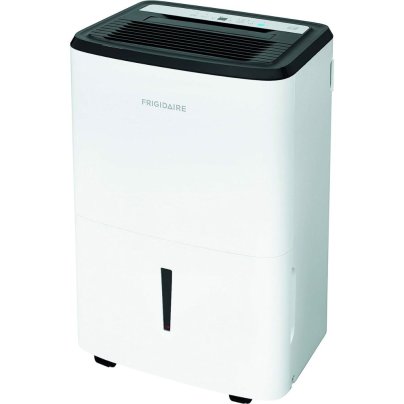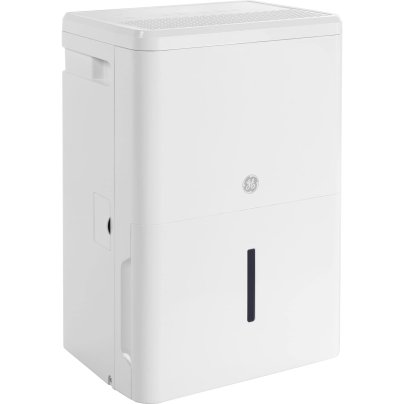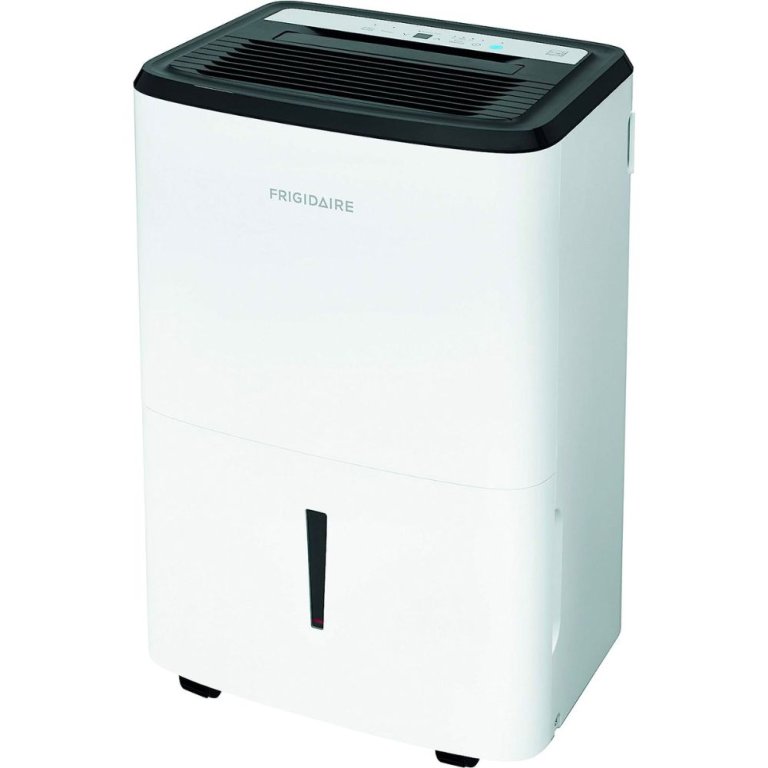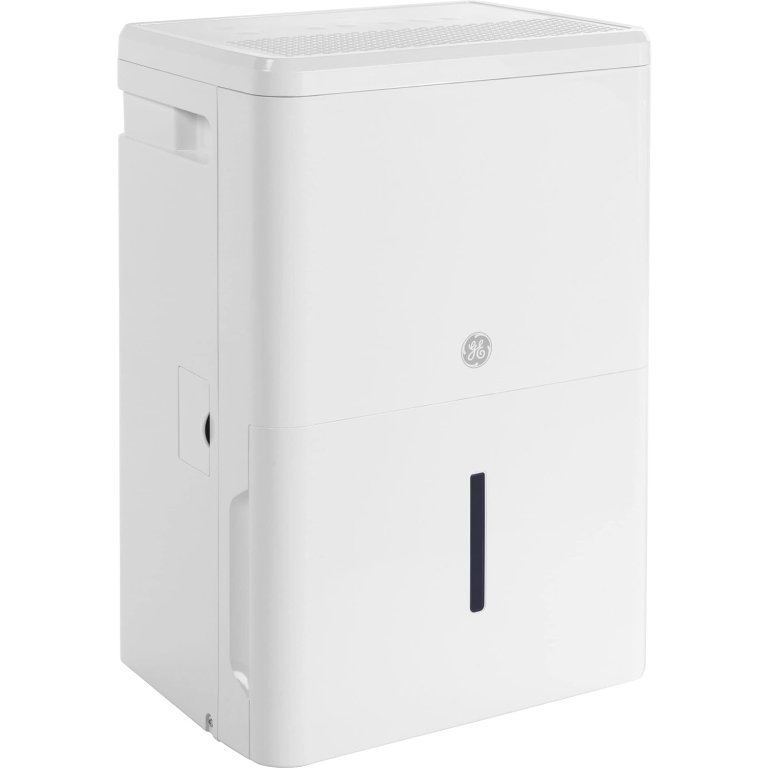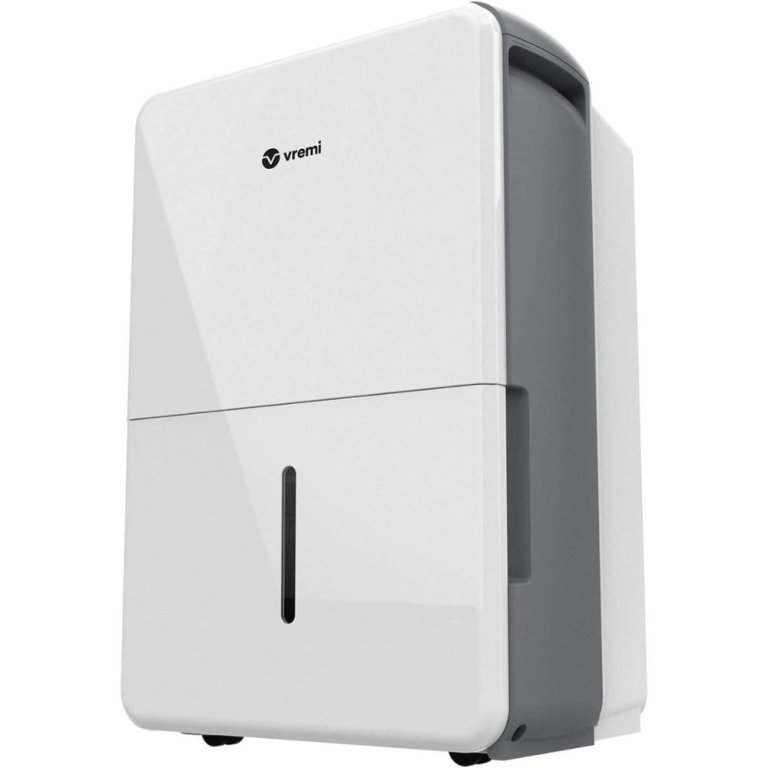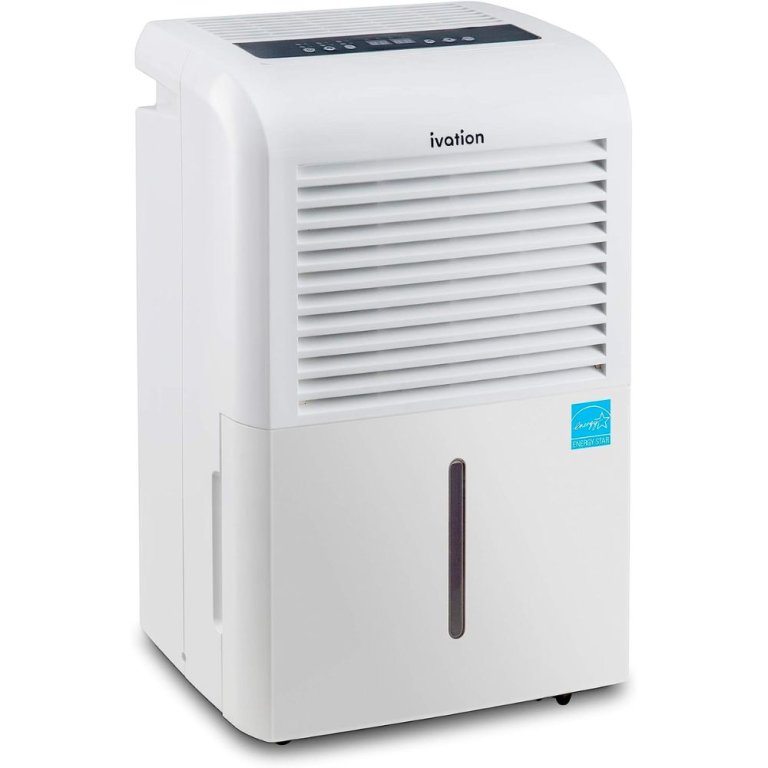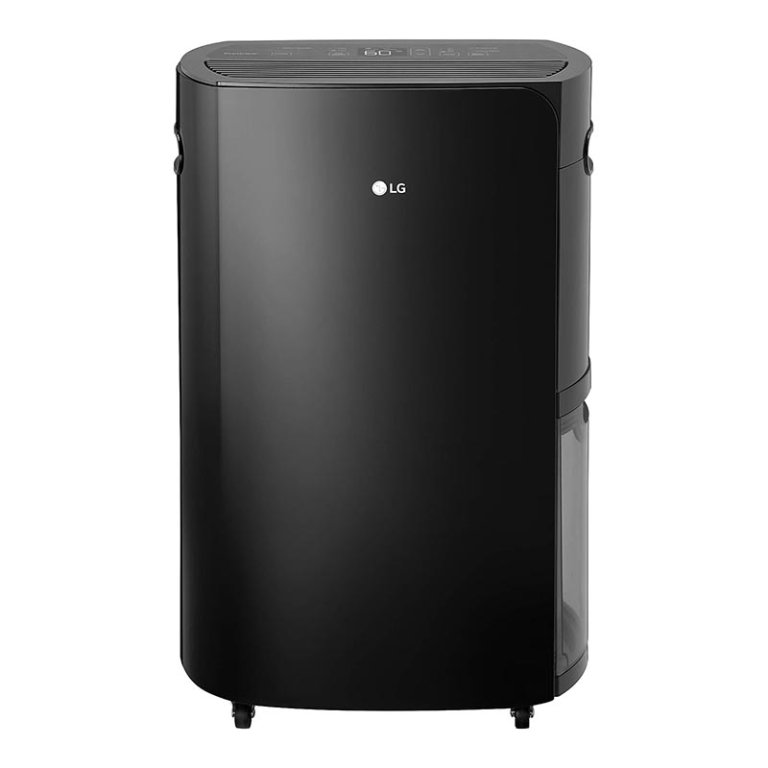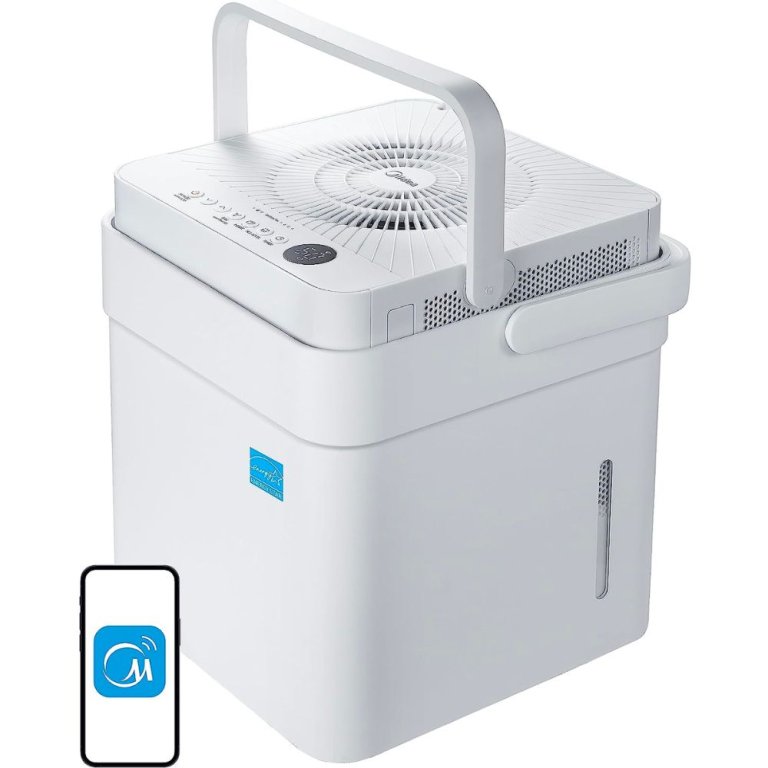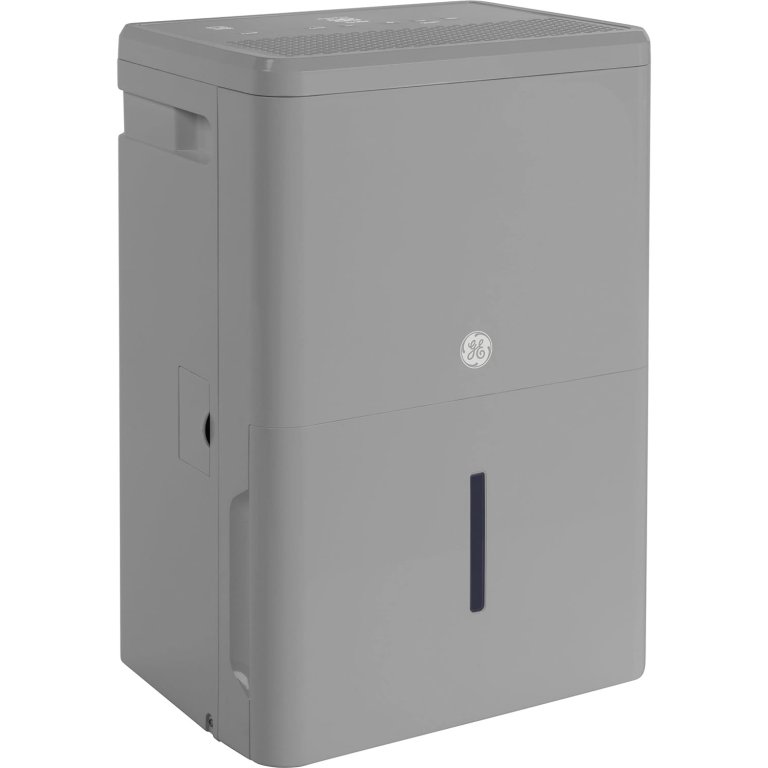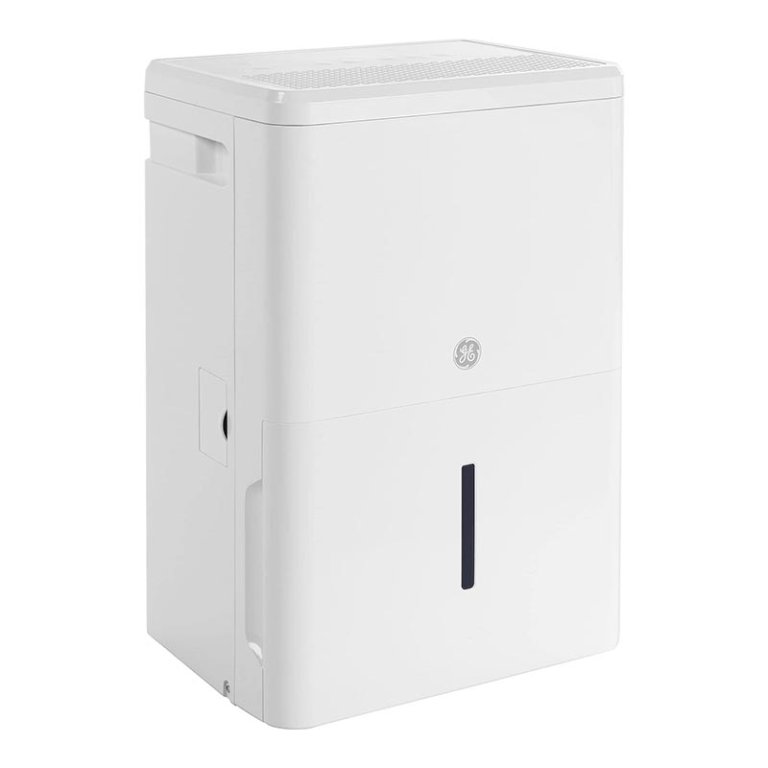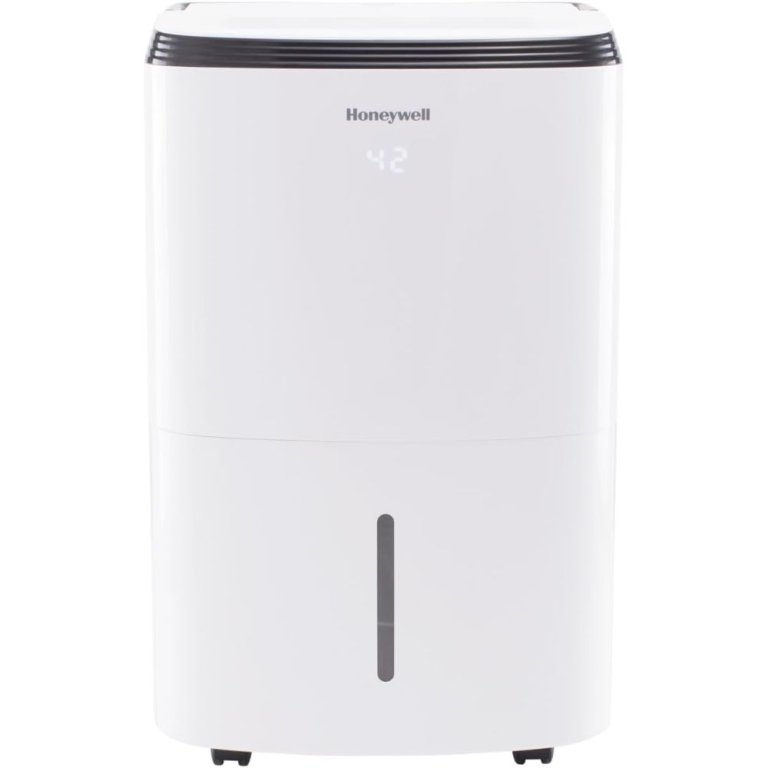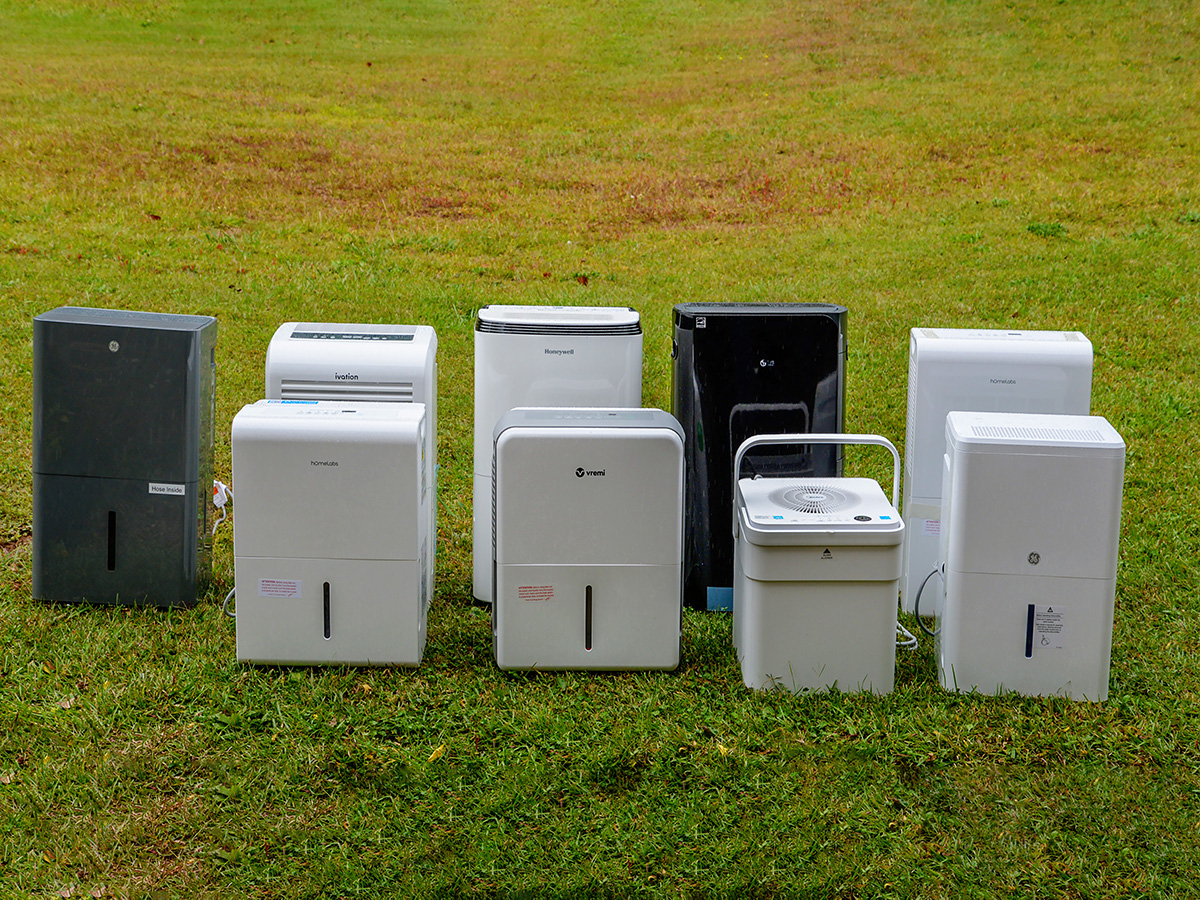
We may earn revenue from the products available on this page and participate in affiliate programs. Learn More ›
Dehumidifiers for basement ventilation reduce the likelihood of mold and mildew growth leading to cleaner, safer air in your home. Since basements are located below ground level, they tend to absorb moisture from surrounding soil, making them damp and musty. Besides damaging furniture and other items stored in the basement, mold spores can incite respiratory and allergic disorders when inhaled.
Tim David, a 30-year veteran HVAC technician and founder of Airlucent.com, says that basement humidity starts with “moisture migration from the soil around the basement seeping into the structure.” He explains, “If the basement has poor ventilation or draining, it will prevent the moisture from escaping, thus causing humidity.” When that happens, the damp environment becomes a haven for mold, mildew, and pest infestations.
If you’re in the market for an appliance that can remove excess moisture from the air to improve air quality and help alleviate pest and allergy problems, then read on. In this guide, we’ll explain how several popular basement dehumidifiers performed in our hands-on tests. We love the Frigidaire 50-Pint Dehumidifier With Built-In Pump because of its 1,500-square-foot coverage area, 50-pint capacity, compact size, automatic operation settings, and built-in 24-hour timer.
While giving the lowdown on our top picks, we’ll also cover how to choose the best dehumidifiers for basements and other areas in your home.
- BEST OVERALL: Frigidaire 50-Pint Dehumidifier With Built-in Pump
↓ Jump to Review - BEST BANG FOR THE BUCK: GE ADHR22LB 22-Pint Dehumidifier With Smart Dry
↓ Jump to Review - BEST FOR SMALL BASEMENTS: Vremi 22-Pint Dehumidifier
↓ Jump to Review - BEST FOR LARGE BASEMENTS: Ivation Large-Capacity Dehumidifier With Pump
↓ Jump to Review - BEST SMART: LG PuriCare 50-Pint Wi-Fi-Enabled Dehumidifier
↓ Jump to Review - BEST COMPACT: Midea Cube 20-Pint Smart Control Dehumidifier
↓ Jump to Review - BEST WITH PUMP: GE APEL50LZ 50-Pint Dehumidifier
↓ Jump to Review - BEST FOR BASEMENT BEDROOMS: hOmeLabs HME020030N 22-Pint Dehumidifier
↓ Jump to Review - BEST FOR COLD BASEMENTS: Honeywell 50-Pint Dehumidifier
↓ Jump to Review
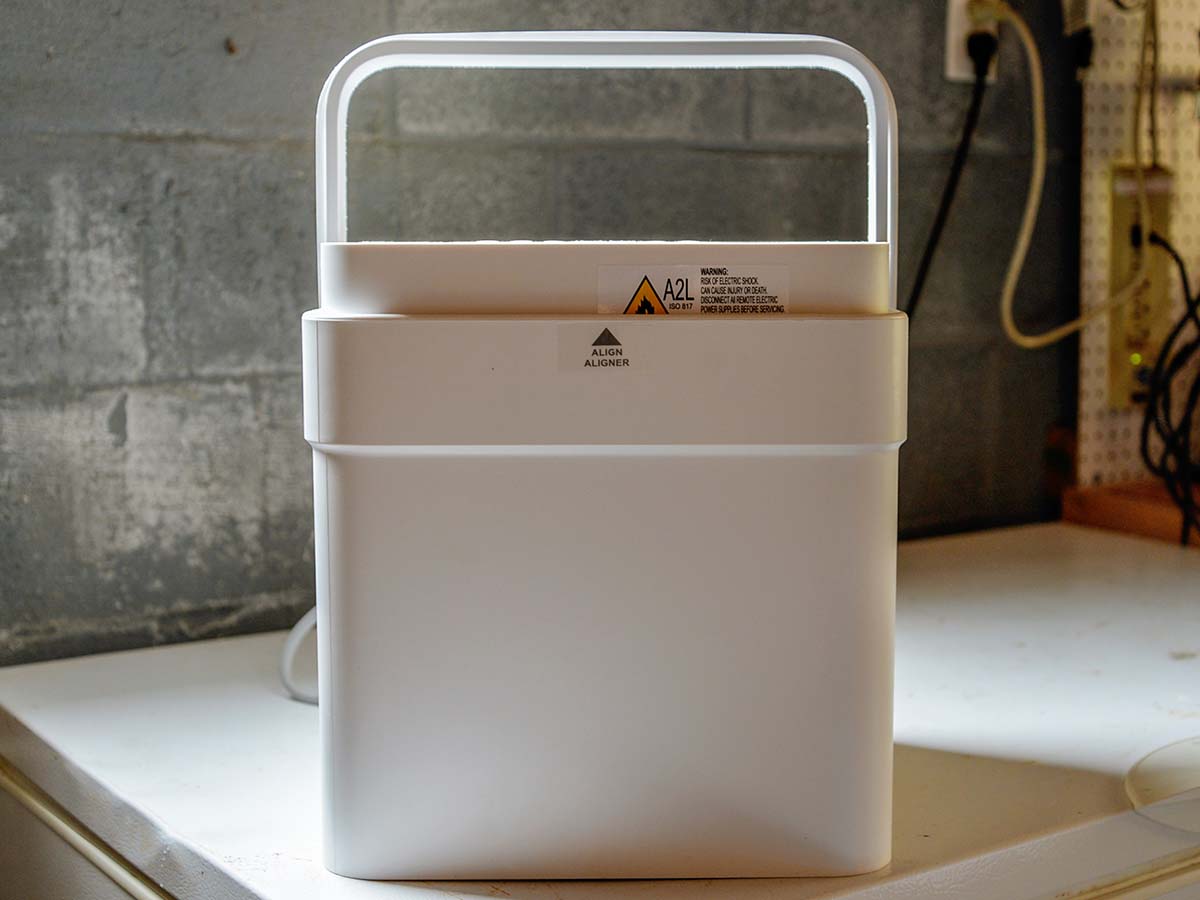
How We Tested the Best Dehumidifiers for Basements
After researching more than 20 appliance brands and 30 dehumidifiers, we selected our top ten choices for testing. All of our picks are Energy Star certified for operational efficiency. These picks represent a wide range of options suited for different budgets and specific needs, such as models that are ideal for unheated basements.
Dehumidifier moisture control ratings are based on lab testing at 65 degrees Fahrenheit and 60 percent relative humidity. For real-world results, we tested each of these models in an unfinished walkout basement that shares a wall with a crawl space. During our testing, the basement temperature varied from 50 to 75 degrees Fahrenheit, and humidity levels ranged between 40 and 70 percent. Our goal was to observe the operational details that make a difference to users, such as ease of use and noise level, as well as a subjective comparison of how the air felt and smelled while using each one.
We measured the physical dimensions of each unit and noted the manufacturer’s moisture removal specs (using pints per 24 hours as a baseline standard). We then ran each unit for 12 hours as it drained into its collection bucket, followed by 72 hours draining into the basement sump. We evaluated each unit according to its air intake and discharge configuration, noise level, the time it took to fill up its collection bucket at higher and lower temperatures, and how effectively it operated while in a continuous drain configuration.
| Testing Stats | |
| Products tested | 9 |
| Hours spent testing | 24 |
| Tests performed | 3 |
| Price range | $173 to $356 |
Our Top Picks
Each of these basement dehumidifiers received high customer reviews and performed well in our independent testing. Whether you’re looking for a small, medium, or large basement dehumidifier, one of these powerful machines could be the right choice.
Best Overall
Frigidaire 50-Pint Dehumidifier With Built-in Pump
What We Like
- Compact unit with castors for mobility; well suited to common basement sizes
- Doesn’t rely on a gravity drain thanks to built-in pump and 3 fan speeds
- Features include auto shutoff, auto restart, and 24-hour timer
- Wi-Fi connectivity for remote control with the Frigidaire app, Amazon Alexa, or Google Assistant
What We Don’t Like
- Optional drain hose not included; must be purchased separately
Product Specs
- Capacity: 50 pints
- Coverage: 1,500 square feet
- Dimensions: 24.75 inches tall by 16 inches wide by 12.25 inches deep
Our Ratings: Ease of Use 4.5/5; Noise 5/5; Effectiveness 4/5; Value 5/5
Read our full review: Frigidaire 50-Pint Dehumidifier With Built-in Pump
Considering the wide range of attractive options on the market, it’s not easy to choose the best dehumidifiers for basements, but the Frigidaire takes our top spot for its combination of control, efficiency, and user-friendly features.
This compact unit has a 50-pint capacity suitable for spaces of up to 1,500 square feet. It features a built-in 24-hour timer, which will restart automatically in the event of a power outage. The three-speed fan gives control over airflow, and the washable filter captures dust and dust mites.
The 2.11-gallon bucket is front mounted, so it’s easy to access, and it comes with a convenient carry handle. There is an automatic shutoff to prevent overflowing. The built-in pump offers continuous draining as an alternative, but a hose will need to be purchased separately (an ordinary garden hose is fine). Castors are fitted to make moving the dehumidifier easy, and at 41 pounds, it isn’t too heavy to be carried upstairs if required.
While all of the dehumidifiers in our test accomplished the task of moisture removal in the same way, what separated this model from the rest was its convenience functions. For example, in our test, the large bucket took nearly 8 hours to fill, which allows the dehumidifier to run nearly constantly overnight or throughout the workday. Three of the competitors filled up after only 6 to 7 hours of runtime, which meant they would automatically stop running for a while overnight or while we were away.
The other feature that made this unit stand out from the others was its smart-control capability, which saved us from making trips up and down the basement stairs. As long as we had a Wi-Fi connection, we could power the unit on and off, adjust the targeted humidity setting, or change the fan’s speed. All this can be done with the Frigidaire app, or by voice with Amazon Alexa or Google Assistant.
Get the Frigidaire dehumidifier for basements at Amazon or The Home Depot.
Best Bang For The Buck
GE ADHR22LB 22-Pint Dehumidifier With Smart Dry
What We Like
- A compact yet full-featured model ideal for those on a limited budget
- Easy-to-use digital controls with auto defrost, auto restart, and filter change reminder
- Alarm warns when bucket is full, and there’s a gravity drain alternative
What We Don’t Like
- Drain hose not included; must purchase separately to use gravity-drain function
Product Specs
- Capacity: 22 pints
- Coverage: 1,500 square feet
- Dimensions: 19.5 inches tall by 13.5 inches wide by 10 inches deep
Our Ratings: Ease of Use 4.5/5; Noise 4/5; Effectiveness 4/5; Value 5/5
Basement bedrooms are a popular home improvement option, but high humidity can wreak havoc on soft furnishings, bedding, and mattresses. This budget-friendly quiet and compact 22-pint GE dehumidifier could be the ideal solution to control basement bedroom humidity.
The unit’s top-mounted LCD screen provides control over the on/off timer and humidity level. Once the latter is set, the Smart Dry function means the dehumidifier can be left to run automatically. The three-speed fan automatically boosts airflow when the humidity gets too high. Dust is removed by a washable filter. There is an auto restart should power be interrupted as well as auto defrost.
Buckets generally have an overflow shutoff, but the 1.1-gallon bucket on this GE dehumidifier also provides a useful audible alarm.
In our tests, the GE 22-pint dehumidifier was one of the quietest models, so the noise is less likely to keep the user awake. It took more than 9 hours for the large bucket to fill, allowing for a full night’s sleep without tripping the full bucket alarm. Discharging dry air from the top of the unit helped to push moist air downward toward the intake, ultimately creating uniform conditions throughout the room. Those with access to a floor drain or sump pump can take advantage of the continuous gravity-drain feature, but a drain hose was not included.
Get the GE 22-pint dehumidifier for basements at Amazon, The Home Depot, or Wayfair.
Best for Small Basements
Vremi 22-Pint Dehumidifier
What We Like
- Offers all the features necessary for small basements at a competitive price
- Turbo mode for rapid dehumidifying; anti-frost setting for all-year operation
- Light overall weight and useful built-in handles make it easy to carry
What We Don’t Like
- Small water-tank capacity; frequent emptying may be necessary
Product Specs
- Capacity: 22 pints
- Coverage: 1,500 square feet
- Dimensions: 19.9 inches tall by 16.1 inches wide by 10.4 inches deep
Our Ratings: Ease of Use 4/5; Noise 4/5; Effectiveness 5/5; Value 4.5/5
At just 33.1 pounds, the compact Vremi dehumidifier is remarkably lightweight, yet it still offers the range of features one would expect from much larger models. Its portability is further enhanced by handles built into the top of the casing.
The desired humidity level can be dialed in via the control panel, but the Vremi is very much designed for unattended operation. It will run automatically until the tank is full, at which point it will shut itself off until emptied. There is also an anti-frost setting for efficient operation in cool temperatures, auto restart in case of a power outage, and a timer.
The only real challenge with this otherwise excellent and very affordable device is its 0.8-gallon water tank, which might need emptying relatively frequently. It can be configured to continuously drain, though a hose is not included.
The Vremi 22-pint dehumidifier operated quietly and efficiently, rolled smoothly on its casters, and was easy to operate. It was a bit bulkier than most of the other 22-pint models in our test group, but it also had a slightly more stylish design. Like the two previously mentioned models, this one features a rear intake with a side discharge. In our basement with a 10-foot ceiling, the dehumidifier tended to maintain a pocket of dry air closer to floor level with humidity rising closer to the ceiling.
Get the Vremi dehumidifier for basements at Amazon, Walmart, or Vremi.
Best for Large Basements
Ivation Large-Capacity Dehumidifier With Pump
What We Like
- Can maintain selected humidity in areas as large as 4,500 square feet
- Timer allows for optimal control; auto shutoff and frost sensor
- The pump allows for continuous operation, and a 16-foot hose is included
What We Don’t Like
- A bit noisier than most of our top picks
Product Specs
- Capacity: 50 pints
- Coverage: 4,500 square feet
- Dimensions: 23.5 inches tall by 15.28 inches wide by 11.1 inches deep
Our Ratings: Ease of Use 4.5/5; Noise 4/5; Effectiveness 4.5/5; Value 4/5
With an adjustable fan speed, an easy-to-program LCD interface, and the ability to maintain preselected humidity levels in large areas, the Ivation dehumidifier is a top-rated option for basements.
With its 50-pint capacity, this is an especially great choice for large basements. Consumers can monitor the current humidity level and program the unit to turn on at preset times. The Ivation comes equipped with an easy-empty 2.25-gallon tank and an optional hose connection. It features a 16-watt built-in pump capable of pumping water as high as 16.4 vertical feet. It also has an automatic shutoff and a restart sensor that detects frost buildup and turns the unit off to allow the frost to melt before turning back on.
The Ivation dehumidifier provided similar moisture removal results to the other 50-pint models in our test group, but it stood out for its versatility. Thanks to its large 2.25-gallon bucket, it was capable of providing the longest operational time before needing to be emptied—a little more than 8.5 hours. It was well balanced and easy to empty when full. The onboard condensate pump allowed us to pump the water to a sink drain for effortless disposal. We also liked that it came with an auto-restart feature in case of power failure and a defrost feature for use in cool-weather operation.
Get the Ivation dehumidifier for basements at Amazon.
Best Smart
LG PuriCare 50-Pint WiFi-Enabled Dehumidifier
What We Like
- Can be monitored and controlled via smartphone, so it’s adjustable even when out of the house
- Compatible with Alexa and Google Assistant, providing hands-free voice activation
- High-capacity bucket with overflow alert; pump for continuous draining
What We Don’t Like
- Only available in black, which may not be to everyone’s taste
Product Specs
- Capacity: 50 pints
- Coverage: 1,000 square feet
- Dimensions: 26.2 inches tall by 16.8 inches wide by 12.6 inches deep
Our Ratings: Ease of Use 4.5/5; Noise 4/5; Effectiveness 4.5/5; Value 4/5
With its black metal casing, the high-quality LG PuriCare dehumidifier makes a striking first impression. It is stronger than many plastic models, though at 45 pounds, there isn’t much of a weight penalty. It is also relatively quiet for a machine at this performance level.
A clear LED panel provides a timer and humidity level controls. There is an overflow alarm and an auto shutoff that enables the dehumidifier to “rest” for 1 hour in every 24-hour cycle to prevent overheating. The bucket is side loading and has a 1.7-gallon capacity. Continuous draining is an option, and the LG also has a pump, so water can be fed to a sink above the height of the unit if necessary.
Paired with the SmartThinQ app, the unit features smart controls. The LG dehumidifier can be started and stopped remotely via phone, and a full bucket alert can be received. Compatibility with Alexa and Google Assistant provides further home integration options.
Although we tested the LG dehumidifier in manual mode, the higher-than-average price and relatively small bucket make it a better option for those who plan to utilize the unit’s full functionality. We really liked how easy it was to use the app and voice command options. This saved us countless trips up and down the basement stairs to check on the machine and change settings. Combined with the pump feature that pushed condensate water up to a sink drain, we were able to “set it and forget it” for the most part. Everything simply worked.
Get the LG dehumidifier for basements at Amazon or The Home Depot.
Best Compact
Midea Cube 20-Pint Smart Control Dehumidifier
What We Like
- Cube design incorporates large bucket and requires minimal space for storage
- Pairs with smartphone app for remote notifications and is compatible with Alexa and Google Assistant
- Gravity draining is an option, and unlike many rivals, a hose is included
What We Don’t Like
- Lacks wheels for mobility; may be difficult for some to move when full
Product Specs
- Capacity: 20 pints
- Coverage: 1,500 square feet
- Dimensions: 13.5 inches tall by 13.5 inches wide by 13.39 inches deep
Our Ratings: Ease of Use 4.5/5; Noise 4/5; Effectiveness 3/5; Value 5/5
The compact Midea Cube dehumidifier’s standout feature is how small it is when its compressor isn’t attached. The 13.5-inch cube fits well in a variety of small spaces. While in use, the compressor unit attaches to the bucket, resulting in a height of 27 inches. This allows the bucket to be a surprisingly capacious 3.2 gallons, so it can be left unattended for long periods. For those who require full-time use, the upper unit could sit on the side of a sink, draining continuously with the use of the provided hose.
The Midea Cube can be paired with a smartphone app, providing real-time monitoring of humidity and water levels and offering full-bucket alerts. It can also be controlled with voice commands via Alexa or Google Assistant.
The Midea Cube dehumidifier was the slowest in our test group when it came to removing humidity from the air, performing at a rate of just under 1 pint per hour. But its generous bucket size allowed it to operate for over 40 hours without tripping the full-bucket alert. For continuous draining, we simply attached the hose and sat the unit on its base with the hose draining into a sump pump. The smart-control features make it a good option for basement storage rooms and other out-of-the-way areas.
Get the Midea dehumidifier for basements at Amazon, Lowe’s, or Walmart.
Best With Pump
GE APEL50LZ 50-Pint Dehumidifier
What We Like
- Powerful built-in pump provides continuous drainage up to 16 feet from the unit
- 3 fan speeds provide versatility to combat high humidity over large areas
- Also features a clear LED display, adjustable humidistat, and auto defrost
What We Don’t Like
- Large-capacity drain bucket may be difficult for some to move when full
Product Specs
- Capacity: 50 pints
- Coverage: 4,500 square feet
- Dimensions: 24 inches tall by 15 inches wide by 11.5 inches deep
Our Ratings: Ease of Use 4.5/5; Noise 4/5; Effectiveness 4.5/5; Value 4/5
Capable of running nonstop, this high-performance dehumidifier can remove 50 pints of water a day while providing precise humidity control. Its three-speed fan allows for increased airflow to handle damp areas more quickly. There is an audible alarm when the bucket is full as well as an alert when the air filter needs to be rinsed. It also has an auto defrost setting and an auto restart feature in the event of power loss.
At 1.9 gallons, this unit’s bucket capacity is greater than many competitors. Constant draining is an option, and this is where this dehumidifier’s main benefit lies. Whereas many dehumidifiers rely on gravity for this, the GE model can pump the water up to 16 feet from the unit to a convenient sink or other outlet. Plus, a hose is included.
When using the bucket to manually dispose of water, the GE 50-pint dehumidifier filled in a little more than 7 hours, but it also featured the strongest water pump in our test group. It pushed drained water over 12 vertical feet in our test, making it a great option when the water must be discharged through an exit point above ground level. It was also one of the quietest units we tested, even with the pump running.
Get the GE 50-pint dehumidifier for basements at Amazon, The Home Depot, or Walmart.
Best For Basement Bedrooms
hOmeLabs HME020030N 22-Pint Dehumidifier
What We Like
- A compact and low-cost model ideal for basement bedrooms
- Energy Star certified for low power consumption, plus 24-hour timer to manage use
- Water can be collected in internal tank or run to gravity drain
What We Don’t Like
- Continuous draining is an option, but drain hose is not included
Product Specs
- Capacity: 22 pints
- Coverage: 1,500 square feet
- Dimensions: 19.7 inches tall by 15.2 inches wide by 10.24 inches deep
Our Ratings: Ease of Use 4.5/5; Noise 5/5; Effectiveness 4/5; Value 4/5
This 22-pint dehumidifier from hOmeLabs is a smaller version of the powerful model that took our Runner-Up award above and shares many valuable features. It’s also very budget-friendly and is Energy Star certified for low power consumption, so it can also help save on utility bills. A 24-hour timer helps further optimize its usage.
With a maximum area of 1,500 square feet, it’s sufficient for basement bedrooms, and even smaller basements. The tank’s capacity is only 0.8 gallons, but it is designed to automatically shut off when full. Continuous draining is an option, but there’s no pump, so it’s gravity only.
Like its larger counterpart, the hOmeLabs 22-pint dehumidifier draws in humid air at the rear of the unit and discharges dry air to the side. This configuration helps keep the heavier dry air closer to bedding, furniture, and other moisture-sensitive items.
In our test, operating this unit was simple, even with the fully manual controls. It took about 7 hours for the bucket to fill. The good news is that the noise level was low, so sleeping with the machine running should be doable. For continuous-drain mode, we had to add our own hose since the manufacturer did not include one.
Get the hOmeLabs dehumidifier for basements at Amazon or hOmeLabs.
Best for Cold Basement
Honeywell 50-Pint Dehumidifier
What We Like
- Auto-defrost feature prevents damage to the device in cold basements
- More compact than many at this performance level
- Straightforward digital control panel and unique frontal display of current humidity level
What We Don’t Like
- Small tank capacity means frequent emptying; does not come with a drain hose
Product Specs
- Capacity: 50 pints
- Coverage: 3,000 square feet
- Dimensions: 20.1 inches tall by 13.2 inches wide by 10.5 inches deep
Our Ratings: Ease of Use 4/5; Noise 4/5; Effectiveness 5/5; Value 4.5/5
The big problem with running some dehumidifiers in cold basement rooms is that if any water in the machine freezes, it can seriously damage the device. Even finished basement rooms may not be immune if they are unheated when not in use. The Honeywell dehumidifier has an auto-defrost feature to overcome this, preventing the compressor from running until it has first melted the ice.
With an area rating of up to 3,000 square feet, this dehumidifier’s performance is impressive considering its compact size. There are digital controls on the top and a subtle display on the front for current humidity. A lift-up handle helps wheel the machine around. The water tank is a little small, but continuous draining is an option.
The Honeywell 50-pint dehumidifier offered excellent moisture removal in warm and cool conditions alike. Using the bucket to dispose of condensation water, it filled up in about 6.75 hours, allowing ample downtime for it to thaw while sitting and waiting to be emptied. We attempted to cause an intentional freeze-up by dropping the humidity setting to 30 percent and attaching the continuous drain hose, but the unit didn’t freeze. It worked smoothly and continuously for 3 days in 50 to 60 degree Fahrenheit temperatures without succumbing to the cold.
Get the Honeywell dehumidifier for basements at Amazon, The Home Depot, or Best Buy.
Jump to Our Top Picks
What to Consider When Choosing a Basement Dehumidifier
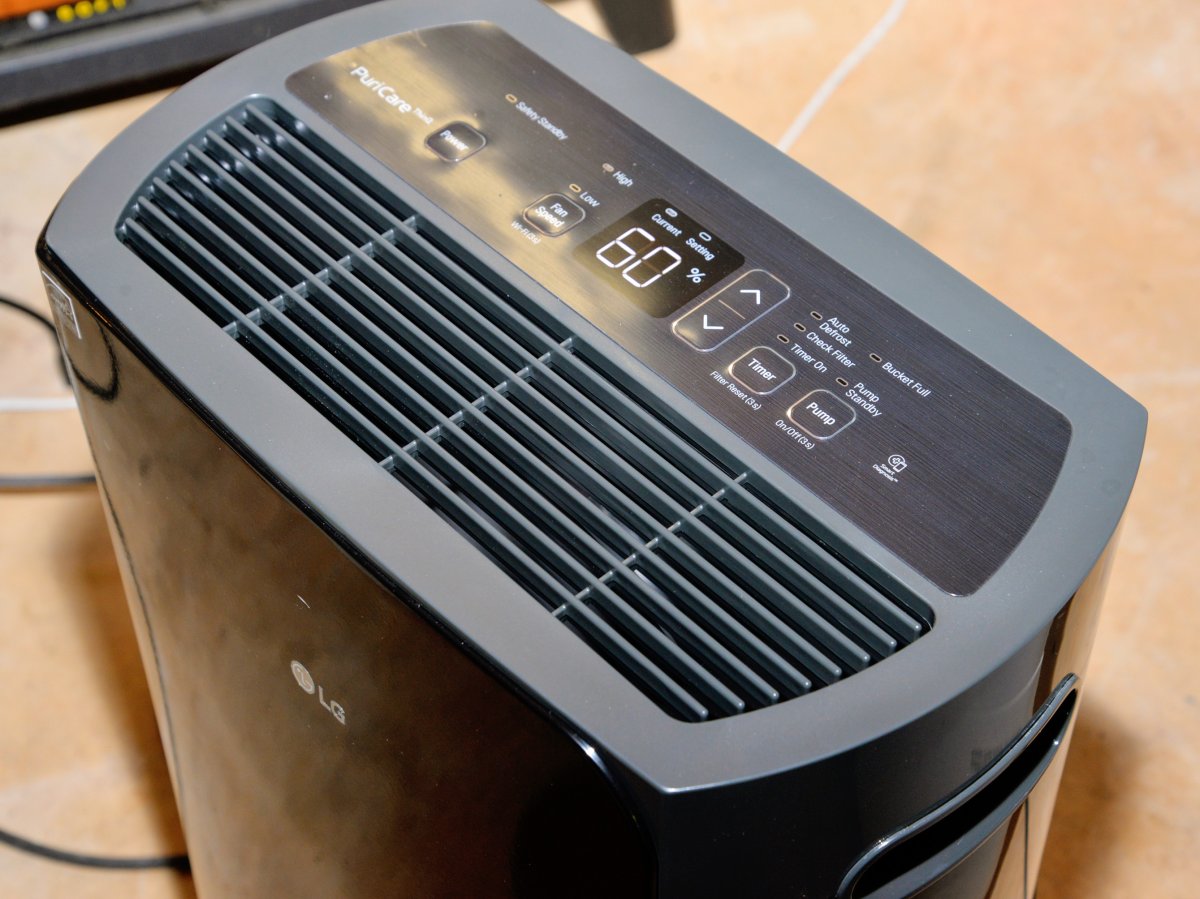
When determining which dehumidifier is best for a basement, shoppers will want to focus on certain qualities. Options for the best dehumidifier for basements will vary greatly in each product’s features, type, capacity, and ease of use. Before selecting a dehumidifier for your needs, consider the size of the space as well as the features required to achieve the desired results.
Type
Different dehumidifiers operate in different ways, and some methods are better suited than others for the high humidity levels found in basements. Here are a few of the most common types of basement dehumidifiers:
- Compressor dehumidifiers: The majority of dehumidifiers for basements use a compressor to operate a fan that draws air over cold coils, causing moisture to condense like droplets on the outside of a cold drink. The droplets then run into a tank, which must be emptied regularly, or to a floor drain via a drain hose. For basements or crawl spaces with high humidity, a compressor dehumidifier may be the best option.
- Desiccant dehumidifiers: With this type of dehumidifier, moist air is drawn through a filter made of a desiccant material (a chemical drying agent). The desiccant traps the moisture, which then drips into a collection tank. Desiccant dehumidifiers can control moisture levels in small rooms above-ground, but they may not be powerful enough for basements.
- Thermo-electric dehumidifiers: Also known as “Peltier dehumidifiers” after physicist Jean Charles Peltier, who discovered the thermoelectric method of extracting moisture from the air, these units work by drawing moist air along the surface of small heated surfaces (called “sinks”) where moisture collects and then drips into a collection tank. Thermoelectric dehumidifiers operate best in warm rooms, and they’re often on the small side. Though they may be the best basement dehumidifiers for small spaces, they aren’t always a good choice for a large or cool basement.
Capacity and Cost
Dehumidifiers are categorized by capacity (how much water they can remove from the air per day.) Though labeled “small, medium, and large,” this sizing refers to their power, not to the capacity of their collection tank. Collection tanks typically hold between 1 and 3 gallons, and as a general rule, the more powerful the dehumidifier, the greater its capacity. To remove the high level of humidity present in many basements, a large-capacity dehumidifier is often necessary.
- Small capacity: These lightweight, portable, and affordable units collect an average of 15 to 30 pints of moisture per day. They’re well suited to small rooms or closets and typically cost less than $150.
- Medium capacity: Capable of collecting 30 to 50 pints of moisture per day, medium-capacity dehumidifiers work well in medium to large rooms but may not be powerful enough for a basement. They generally cost up to $250.
- Large capacity: With the ability to remove up to 70 pints of moisture per day, a large-capacity unit is the best dehumidifier for basement mold. Expect to pay between $250 and $350 for one of these units.
Depending on one’s utility rates, the size of the basement, and the humidity levels, it costs an average of $25 to $50 per month to operate a large-capacity dehumidifier. While today’s dehumidifiers are more energy efficient than those made a decade ago, it’s wise to look for Energy Star certification when shopping. These models are the most efficient, and they could save up to 30 percent on electricity compared to a standard machine.
What’s another component that can affect cost? David points out that “high humidity can weaken building materials, making them susceptible to rot and decay.” Dealing with that type of situation can cost owners thousands. David adds, “You can’t forget the energy angle as higher humidity levels can make a home feel hotter in the summer and colder in the winter, which puts more stress on your HVAC or heating units.”
Drainage
All dehumidifiers come with collection tanks, but some models also offer the option to attach a drainage hose (typically a standard garden hose) to direct collected moisture into a floor drain. Most basement dehumidifiers will automatically shut off when the collection tank is full, so if the user won’t be able to manually empty the dehumidifier on a regular basis, they’ll probably want to purchase a unit with a drain hose.
Keep in mind that a pint weighs approximately 1 pound, so while a large-capacity dehumidifier can collect up to 75 pints a day, tanks generally hold up to 3 gallons to allow for easy, frequent emptying. Only the mightiest of bodybuilders would want to haul a 75-pound collection tank around.
Additional Features
Most dehumidifiers let the user select a humidity level: normal, dry, or very dry. Aside from this basic function, the top dehumidifiers for basements have additional features that users might find useful.
- Digital controls allow the user to select the desired humidity level by percentages, such as 35 percent or 45 percent humidity. The unit will shut off automatically when the moisture in the room meets the preset level and then turn back on as necessary.
- Timers allow the user to program and turn the dehumidifier on/off automatically at a preset time.
- Memory or auto restart: Many of the most humid months bring thunderstorms with them, which often knock out the power. Some models with auto-restart or memory functions will remember their settings prior to the power outage and continue working where they left off.
- Easy-carry collection tanks with comfortable handles and a well-designed spout allow the user to dump water without spilling.
- Frost sensors detect frost buildup and turn the machine off to save energy. When a compressor unit runs for long periods of time, frost can develop on the coils, which reduces the dehumidifier’s effectiveness. While a unit with frost buildup will continue to run, it won’t remove moisture from the air as effectively. Some models also come with a restart feature that turns the unit back on after the coils have defrosted.
- Water-level sensors alert the user when the water level in the tank is approaching or has reached max capacity. Though most produce an auditory alarm, some models will also alert the user via smartphone.
- Humidistats, also known as “hygrostats,” measure the humidity in the air to control excess moisture. Once a humidity level is programmed into the dehumidifier, the humidistat will automatically adjust its operation to keep the room at the desired moisture level.
- Wheels are usually attached to portable units, allowing the user to move the dehumidifier with ease.
Noise Level
Dehumidifiers generate a noise similar to the hum of a window air conditioner, and the larger the capacity, the louder the device tends to be. Most dehumidifiers produce between 53 decibels (comparable to a normal conversation) and 65 decibels (comparable to the sound of street traffic), but manufacturers aren’t required to list the noise levels on their units.
Reading customer reviews is the best way to determine how noisy a dehumidifier will be. Placing the unit on a level surface can also help reduce noise.
Basement Dehumidifier Brands to Consider
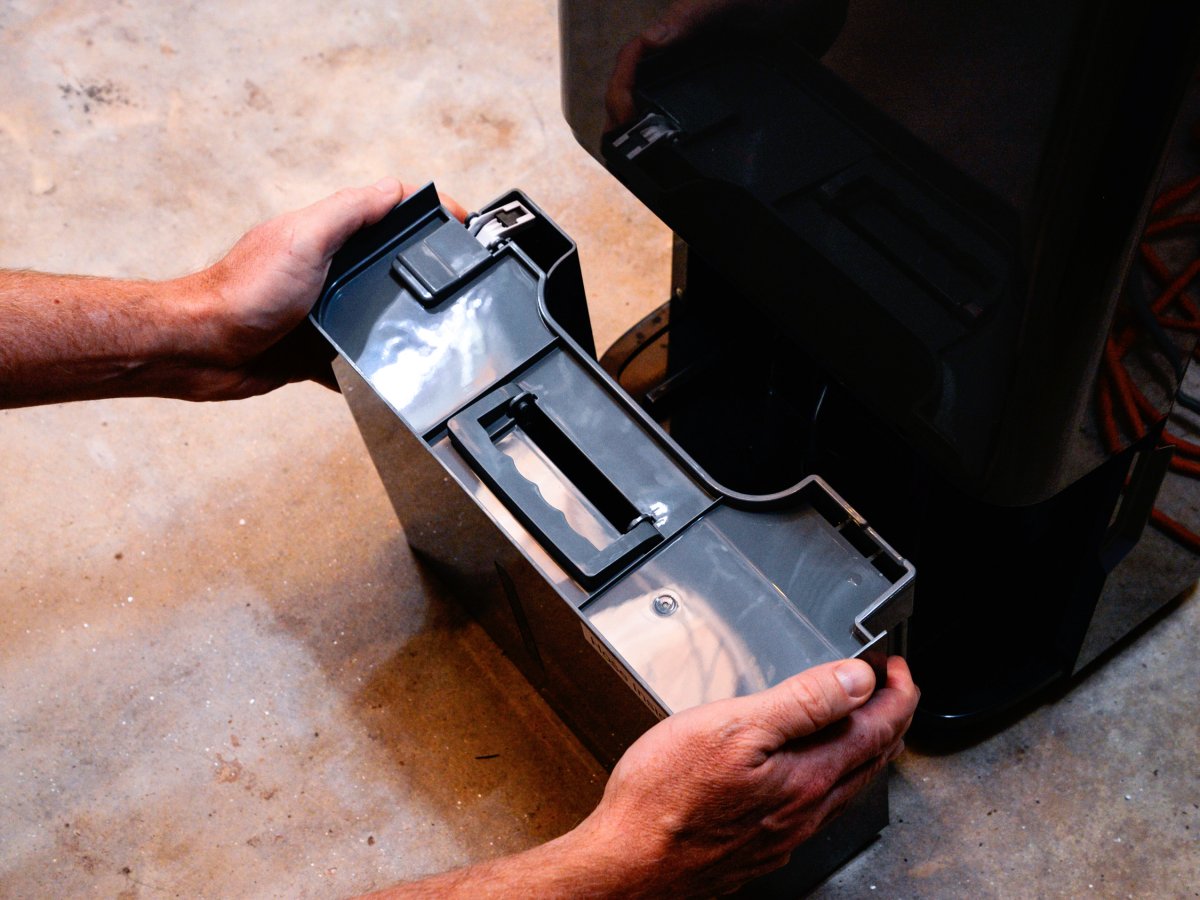
To get a better sense of the dehumidifiers on the market today, here are a few of the most trusted brands we recommend:
- Honeywell is one of the most well-known brands for air filtration and quality with dehumidifiers, heaters, thermostats, and more in their inventory. With 11 different dehumidifier models available, there is a range of options for spaces up to 4,000 square feet at affordable price points. Capable of dehumidifying anywhere from 30 to 70 pints of moisture a day, many of these Energy Star–certified models also come equipped with pumps, wheels, and handles for portability and ease of use. Finally, each of the dehumidifiers in their inventory comes with glossy white constructions that look good in any room.
- hOmeLabs offers a wide range of dehumidifier models intended for commercial and residential use. Though they also carry high-efficiency particulate air filters, refrigerators, air conditioners, kitchen appliances, and more, their dehumidifiers are some of the most popular products sold in their inventory. This brand offers dehumidifiers for small and large spaces, and most models have built-in wheels and handles for maneuvering. For added convenience, this brand has select models that are Energy Star certified, and all of the dehumidifiers are budget-friendly.
- Frigidaire offers high-tech dehumidifiers with Energy Star certifications and Wi-Fi connectivity included. Though a few of their dehumidifiers are on the pricey side, some of their large picks can remove 60 pints worth of humidity per day. For smaller spaces, smaller units are available, such as 22-pint and 35-pint models. Digital control panels; ionizers for airborne particles; and the convenience of washable, reusable filters also make this brand’s dehumidifiers convenient and easy to use.
- LG offers a smart dehumidifier that comes with built-in wheels, a large digital control panel, and an Energy Star certification. As LG constructs many types of household appliances and tools, this brand has a stellar reputation and a loyal customer base. Its dehumidifier offers the same reliability and ease of use as many of its appliances, as it has a safety standby, thermal resistance, and a sturdy metal construction. It also drains continuously and offers humidity auto control, a washable filter, and automatic restart.
- AprilAire creates reliable dehumidifiers, humidifiers, thermostats, air purifiers, filters, and more. Though some products are on the expensive side, this company values innovative, reliable designs in small and large spaces. Founded in 1954, this Energy Star–certified brand includes digital control panels and corrosion-resistant coils on their products for long lifespans and durability. When it comes to this brand’s dehumidifiers, each one comes with a built-in drain and only requires yearly maintenance and filter replacement. Plus, this brand offers models that are compatible with enormous basement spaces.
- Haier offers four different types of dehumidifiers ranging from 20- to 50-pint ratings. Though this brand is well known for kitchen, laundry, and air-quality appliances, its dehumidifiers come with smart technology, including smart dry, an empty-bucket alarm, built-in pumps, and filter reminders. Each of its dehumidifiers is also Energy Star certified, affordable, and comes in glossy white constructions with wheels to fit in any space.
- Toshiba is a well-known brand for cooking appliances, air conditioners, and, of course, dehumidifiers. With units ranging from 20 to 50 pints, each comes equipped with automatic and manual humidity settings, change-filter and full-tank alerts, and Energy Star certification. Select picks also have built-in wheels and a continuous-run option. Though these dehumidifiers are reliable and affordable, none of them come with a drain hose.
FAQs
Choosing the best dehumidifiers for basements can be a complex process. While we hope our guide has answered many buyers’ questions about basement dehumidifiers, there are a number of other issues that crop up frequently. We’ve provided answers to those questions below.
Removing moisture under the house can benefit the floor above. However, the most effective whole-house solution is usually a dehumidifier that works with your HVAC system.
The size of the basement and the level of humidity have an impact. Our top picks include a variety of models to suit different basements of different sizes.
This depends on how humid the basement is. It may be necessary to run the dehumidifier 24/7, but anywhere from 12 to 18 hours could be sufficient. Smart dehumidifiers provide constant monitoring, so you can adjust accordingly.
It depends where the air exits the unit. If the unit discharges air at the top, it can be placed near a wall. Otherwise, it may need 12 to 18 inches of space for proper airflow. Try not to place it near windows or doors, which attract excess humidity. The dehumidifier manufacturer should provide further guidance.
The recommended summer rate is 30 to 50 percent. This should prevent the formation of mold and mildew. In winter, the humidity level can be set at 40 to 60 percent.
It’s likely that the air in the basement is too cold. If possible, try raising the basement temperature a couple of degrees Fahrenheit. If the dehumidifier is running all the time, try switching it off at night. It may also help to raise it above floor level.
Most basement dehumidifiers drain into a removable bucket or via a hose, though the hose is often not included.
It can be challenging to dry a basement without a dehumidifier. Good airflow is very important, and a fan may help. Avoid putting damp clothes in the space. Charcoal or other desiccant material can help soak up some of the excess moisture.
Cleaning a dehumidifier should be relatively straightforward; most parts just need to be wiped down with a damp cloth. It’s possible the reservoir may have a buildup of limescale, which can usually be removed with white vinegar or lemon juice. An air filter typically needs a quick rinse once a month. To ensure the longevity of your machine, it is vital that you follow the manufacturer’s instructions.
Meet the Tester
A writer with an extensive background in the green industry, Mark Wolfe is an avid DIYer who lives in a 50-year-old home. When he isn’t writing, he spends his time upgrading, repairing, and replacing anything and everything in his home, yard, and garden. He tests and writes reviews about hand tools, lawn-care and home-repair products, and outdoor-living goods.
Additional research provided by Glenda Taylor and Bob Beacham.
